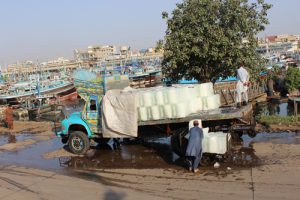On Sunday evening, May 31, executives of Environmental Resources Management, a British research consultancy, joined the principals of the HKND Group, a Hong Kong-based development group set on building a canal across Nicaragua, in a private ceremony in Managua.
The event was held to formally submit a 14-volume study to Nicaraguan authorities on the environmental and social consequences of constructing a new and mammoth shipping corridor across Central America.
The following day, in a made-for-television press event, a copy of the 14-volume Environmental and Social Impact Assessment of the proposed Nicaragua Canal was displayed on a small table for news photographers.
Though the study is not available for public review, ERM and HKND executives joined government authorities in asserting that the canal construction is safe and feasible, and they defended the quality of the environmental assessment, which the government and HKND say is central to the case for starting excavation, perhaps before the end of the year.
“The purpose of the study is to provide an objective, current assessment based on science,” Manuel Coronel Kautz, the president of Nicaragua’s Grand Canal Authority, told reporters.
Edwin Castro, a senior Sandanista official, added that “this is the work of more than two years by ERM, with all the scientific means and serious business of ERM.”
The quality of ERM’s data, though, and the accuracy of its conclusions about the potential harms from canal construction and operation, are not nearly as airtight as Nicaraguan authorities and HKND affirm.
In March, ERM invited 15 environmental scientists and project experts to Miami to spend two days reviewing four chapters of the environmental assessment. In an 11-page evaluation obtained by Circle of Blue, the panel’s members concluded this spring that ERM’s environmental study is rife with significant flaws.
The gravest areas of concern, said panel members, involved understanding the geology beneath Lake Nicaragua, the disposal of 1.1 billion metric tonnes of silt that would be dredged from the lake for shipping channels nearly 28 metres (91 feet) deep and up to 520 metres (1,700 feet) wide.
The academic panel also questioned whether there would be sufficient supplies of water to operate two sets of locks in the event of deep and prolonged droughts that are anticipated in the region due to climate change.
“It seemed to me that the environmental impact assessment process was to create the illusion of science,” said Michael T. Brett, a professor in the Department of Civil and Environmental Engineering at the University of Washington in Seattle, during an interview with Circle of Blue. “I had the impression that most of the sections presented to us were of the quality of a weak Master’s thesis at any major research university. We kept asking, ‘Couldn’t this have been done better?’ It’s not very good work.”
Panel members also said in interviews that they wondered if the study’s weaknesses would jeopardise ERM’s global reputation for thorough and first-rate work.
When asked about that concern, David Blaha, a principal partner at London-based ERM, emailed this response to Circle of Blue:
“As you may know, ERM sponsored the expert panel. We did not need to do this but we believed a project of this magnitude deserved this level of review. ERM was very appreciative of the comments we received from the panel and we responded to all of their comments in the Environmental and Social Impact Assessment (ESIA).
We believe the ESIA is a robust document and objectively evaluates the effects of the project. I encourage you to review the ESIA (or at least the executive summary), once it is available, before reaching any conclusions about the document.”
Circle of Blue also obtained a copy of ERM’s 16-page response to the special panel, which is the only portion of the 14-volume study that has been made public. In its response, ERM generally agreed with the weaknesses in the work that the panel illustrated and said that some analysis had been reworked.
As proposed by HKND, the Nicaragua Canal would be more than three times longer than the Panama Canal; include two sets of monumental locks, larger than those currently under construction at the Panama Canal; require the construction of a 395-square-kilometre (152-square-mile) artificial lake; and force thousands of people from their homes.
As noted in the special panel’s report, the entire corridor proposed for construction — and the coastal marine environments in close proximity to the canal’s Pacific and Caribbean entrances — supports strong fisheries, is a storehouse of exotic tropical plant and animal species, and is home to dozens of indigenous human communities.
Safety of Canal Project Far From Assured
“We were most concerned about the lack of information collected and presented,” said Sudeep Chandra, an associate professor of biology at the University of Nevada in Reno, during an interview with Circle of Blue.
“It wasn’t just about the impact on the environment. It’s also about the feasibility of the project. There didn’t seem to be enough due diligence to see whether the project was even feasible. We were just so surprised by the lack of response to each of our points. I would suggest it is one of the most mismanaged environmental reviews I have ever read.”
One of the panel’s deepest concerns is the safety of Lake Nicaragua, Central America’s largest lake and a relatively shallow, clean, and oxygen-rich source of fresh water for thousands of people and a thriving fishery. HKND proposes to cut a 105-kilometre (40-mile) channel across the lake so deep and wide that it would require a wet-excavation project of silt and mud five times larger than constructing the offshore airport in Hong Kong, which is the largest such wet-excavation project ever conducted.
HKND proposes to build three islands in the lake to dispose a portion of the dredge spoils. The rest would be dumped into the lake to settle to the bottom in 3-metre-tall (9-foot-tall) berms that would run the length of both sides of the dredged channel.
The panel found that the data for understanding the consequences on fisheries and water quality from dumping that much fine silt into the lake was “limited.” That did not stop ERM researchers from arguing in their draft environmental assessment that “the magnitude of the impact is considered small.”
The 15-member panel found that conclusion absurd.
“This finding of moderate significance of dredging impact simply is scientifically indefensible,” the panel concluded in their report. Pouring so much fine silt into a shallow lake would cloud the water, cause oxygen-starved conditions, introduce nutrients that lead to dense algae blooms, dramatically damage the lake’s important fisheries, and seriously degrade the lake as a source of drinking water.
“This fine-grained clay will likely have a large impact on the in-lake sediment disposal plan and result in severe water quality impairment,” said the panel report.
The panel also criticised ERM surveys of existing plant and animal life in the canal corridor, calling the consultancy’s data gathering “brief and incomplete.” Panel members noted that little attention was paid by ERM researchers on the effect that the canal would have on the ability of animals to migrate freely, because the proposed canal would form a new terrestrial barrier.
Another of the panel’s concerns was large gaps in the environmental subjects that ERM researchers chose to address. For instance, ERM did not consider the canal’s potential to affect the Pacific Coast of Nicaragua, which is one of the world’s most important habitats and nesting beaches for four of the seven species of sea turtles.
The Nicaraguan government has not made the ERM study public, nor has it indicated when it will do so. Panel members said it is imperative that the 14-volume study be available for public review.
“That is the most urgent short-term concern with the process,” said Ryan Stoa, a lawyer and senior scholar at Florida International University who helped to organise the independent review panel.
“The government is holding it back. It’s hard for anyone to judge the merits of the study without seeing the research in its entirety. It’s troubling for us that the government has not publicly released the report or even indicated when they will do so. While the science we reviewed was problematic, I expect the final ESIA will raise serious concerns about the impacts of the canal. It’s imperative that the public have access to that research sooner rather than later.”
“It’s safe to say that all of us are very concerned about the potential environmental impacts of a project of this scale,” added Adam Henson, a member of the panel and technical director with Fauna & Flora International, a respected international conservation organisation that has worked in Nicaragua since 1998.
“We are most interested in a scientifically robust, publicly transparent environmental assessment process. At this stage, we hope the ESIA will be released for public comment to ensure a robust scientific review and wide consultation with the Nicaraguan scientific community and civil society in general.”
This article was originally published by Circle of Blue. To view the original article click here.
chinadialogue’s coverage of the environmental impact of the Nicaragua Canal can be read here







